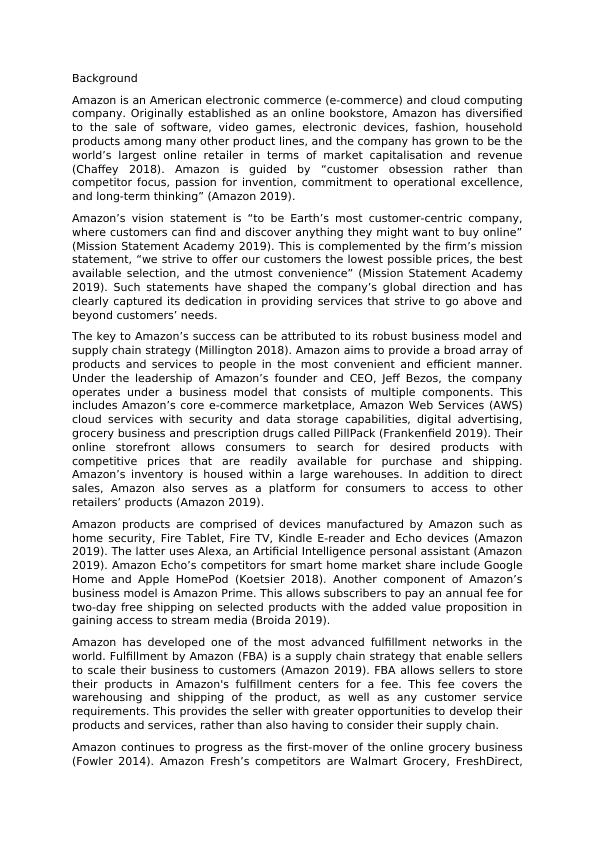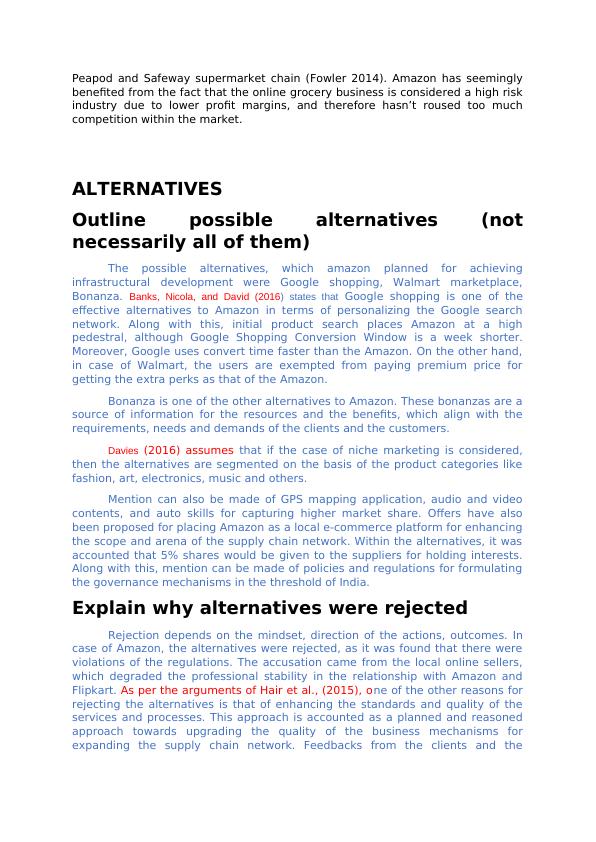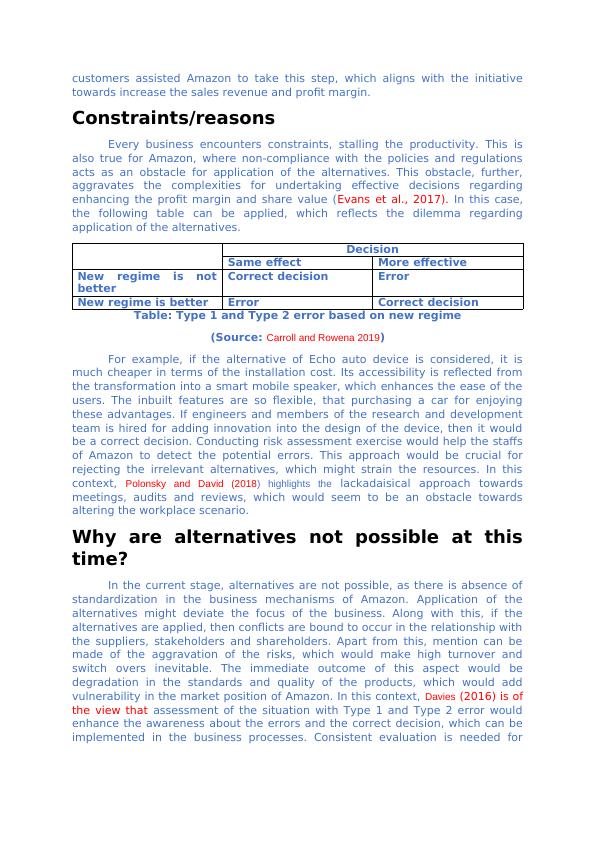Capturing the Automotive Market: Opportunities and Challenges for Amazon
Analyzing Amazon's success through its business model and supply chain strategy
10 Pages5128 Words51 Views
Added on 2022-10-15
About This Document
This article explores the potential for Amazon to capture the automotive market by integrating Alexa into cars and workplaces, and providing reliable GPS mapping and audio and video content. It discusses the challenges Amazon faces in competing with market leaders such as Google and Netflix, and the strategic advantages they have in their extensive fleet of vehicles and proprietary algorithms.
Capturing the Automotive Market: Opportunities and Challenges for Amazon
Analyzing Amazon's success through its business model and supply chain strategy
Added on 2022-10-15
ShareRelated Documents
Background
Amazon is an American electronic commerce (e-commerce) and cloud computing
company. Originally established as an online bookstore, Amazon has diversified
to the sale of software, video games, electronic devices, fashion, household
products among many other product lines, and the company has grown to be the
world’s largest online retailer in terms of market capitalisation and revenue
(Chaffey 2018). Amazon is guided by “customer obsession rather than
competitor focus, passion for invention, commitment to operational excellence,
and long-term thinking” (Amazon 2019).
Amazon’s vision statement is “to be Earth’s most customer-centric company,
where customers can find and discover anything they might want to buy online”
(Mission Statement Academy 2019). This is complemented by the firm’s mission
statement, “we strive to offer our customers the lowest possible prices, the best
available selection, and the utmost convenience” (Mission Statement Academy
2019). Such statements have shaped the company’s global direction and has
clearly captured its dedication in providing services that strive to go above and
beyond customers’ needs.
The key to Amazon’s success can be attributed to its robust business model and
supply chain strategy (Millington 2018). Amazon aims to provide a broad array of
products and services to people in the most convenient and efficient manner.
Under the leadership of Amazon’s founder and CEO, Jeff Bezos, the company
operates under a business model that consists of multiple components. This
includes Amazon’s core e-commerce marketplace, Amazon Web Services (AWS)
cloud services with security and data storage capabilities, digital advertising,
grocery business and prescription drugs called PillPack (Frankenfield 2019). Their
online storefront allows consumers to search for desired products with
competitive prices that are readily available for purchase and shipping.
Amazon’s inventory is housed within a large warehouses. In addition to direct
sales, Amazon also serves as a platform for consumers to access to other
retailers’ products (Amazon 2019).
Amazon products are comprised of devices manufactured by Amazon such as
home security, Fire Tablet, Fire TV, Kindle E-reader and Echo devices (Amazon
2019). The latter uses Alexa, an Artificial Intelligence personal assistant (Amazon
2019). Amazon Echo’s competitors for smart home market share include Google
Home and Apple HomePod (Koetsier 2018). Another component of Amazon’s
business model is Amazon Prime. This allows subscribers to pay an annual fee for
two-day free shipping on selected products with the added value proposition in
gaining access to stream media (Broida 2019).
Amazon has developed one of the most advanced fulfillment networks in the
world. Fulfillment by Amazon (FBA) is a supply chain strategy that enable sellers
to scale their business to customers (Amazon 2019). FBA allows sellers to store
their products in Amazon's fulfillment centers for a fee. This fee covers the
warehousing and shipping of the product, as well as any customer service
requirements. This provides the seller with greater opportunities to develop their
products and services, rather than also having to consider their supply chain.
Amazon continues to progress as the first-mover of the online grocery business
(Fowler 2014). Amazon Fresh’s competitors are Walmart Grocery, FreshDirect,
Amazon is an American electronic commerce (e-commerce) and cloud computing
company. Originally established as an online bookstore, Amazon has diversified
to the sale of software, video games, electronic devices, fashion, household
products among many other product lines, and the company has grown to be the
world’s largest online retailer in terms of market capitalisation and revenue
(Chaffey 2018). Amazon is guided by “customer obsession rather than
competitor focus, passion for invention, commitment to operational excellence,
and long-term thinking” (Amazon 2019).
Amazon’s vision statement is “to be Earth’s most customer-centric company,
where customers can find and discover anything they might want to buy online”
(Mission Statement Academy 2019). This is complemented by the firm’s mission
statement, “we strive to offer our customers the lowest possible prices, the best
available selection, and the utmost convenience” (Mission Statement Academy
2019). Such statements have shaped the company’s global direction and has
clearly captured its dedication in providing services that strive to go above and
beyond customers’ needs.
The key to Amazon’s success can be attributed to its robust business model and
supply chain strategy (Millington 2018). Amazon aims to provide a broad array of
products and services to people in the most convenient and efficient manner.
Under the leadership of Amazon’s founder and CEO, Jeff Bezos, the company
operates under a business model that consists of multiple components. This
includes Amazon’s core e-commerce marketplace, Amazon Web Services (AWS)
cloud services with security and data storage capabilities, digital advertising,
grocery business and prescription drugs called PillPack (Frankenfield 2019). Their
online storefront allows consumers to search for desired products with
competitive prices that are readily available for purchase and shipping.
Amazon’s inventory is housed within a large warehouses. In addition to direct
sales, Amazon also serves as a platform for consumers to access to other
retailers’ products (Amazon 2019).
Amazon products are comprised of devices manufactured by Amazon such as
home security, Fire Tablet, Fire TV, Kindle E-reader and Echo devices (Amazon
2019). The latter uses Alexa, an Artificial Intelligence personal assistant (Amazon
2019). Amazon Echo’s competitors for smart home market share include Google
Home and Apple HomePod (Koetsier 2018). Another component of Amazon’s
business model is Amazon Prime. This allows subscribers to pay an annual fee for
two-day free shipping on selected products with the added value proposition in
gaining access to stream media (Broida 2019).
Amazon has developed one of the most advanced fulfillment networks in the
world. Fulfillment by Amazon (FBA) is a supply chain strategy that enable sellers
to scale their business to customers (Amazon 2019). FBA allows sellers to store
their products in Amazon's fulfillment centers for a fee. This fee covers the
warehousing and shipping of the product, as well as any customer service
requirements. This provides the seller with greater opportunities to develop their
products and services, rather than also having to consider their supply chain.
Amazon continues to progress as the first-mover of the online grocery business
(Fowler 2014). Amazon Fresh’s competitors are Walmart Grocery, FreshDirect,

Peapod and Safeway supermarket chain (Fowler 2014). Amazon has seemingly
benefited from the fact that the online grocery business is considered a high risk
industry due to lower profit margins, and therefore hasn’t roused too much
competition within the market.
ALTERNATIVES
Outline possible alternatives (not
necessarily all of them)
The possible alternatives, which amazon planned for achieving
infrastructural development were Google shopping, Walmart marketplace,
Bonanza. Banks, Nicola, and David (2016) states that Google shopping is one of the
effective alternatives to Amazon in terms of personalizing the Google search
network. Along with this, initial product search places Amazon at a high
pedestral, although Google Shopping Conversion Window is a week shorter.
Moreover, Google uses convert time faster than the Amazon. On the other hand,
in case of Walmart, the users are exempted from paying premium price for
getting the extra perks as that of the Amazon.
Bonanza is one of the other alternatives to Amazon. These bonanzas are a
source of information for the resources and the benefits, which align with the
requirements, needs and demands of the clients and the customers.
Davies (2016) assumes that if the case of niche marketing is considered,
then the alternatives are segmented on the basis of the product categories like
fashion, art, electronics, music and others.
Mention can also be made of GPS mapping application, audio and video
contents, and auto skills for capturing higher market share. Offers have also
been proposed for placing Amazon as a local e-commerce platform for enhancing
the scope and arena of the supply chain network. Within the alternatives, it was
accounted that 5% shares would be given to the suppliers for holding interests.
Along with this, mention can be made of policies and regulations for formulating
the governance mechanisms in the threshold of India.
Explain why alternatives were rejected
Rejection depends on the mindset, direction of the actions, outcomes. In
case of Amazon, the alternatives were rejected, as it was found that there were
violations of the regulations. The accusation came from the local online sellers,
which degraded the professional stability in the relationship with Amazon and
Flipkart. As per the arguments of Hair et al., (2015), one of the other reasons for
rejecting the alternatives is that of enhancing the standards and quality of the
services and processes. This approach is accounted as a planned and reasoned
approach towards upgrading the quality of the business mechanisms for
expanding the supply chain network. Feedbacks from the clients and the
benefited from the fact that the online grocery business is considered a high risk
industry due to lower profit margins, and therefore hasn’t roused too much
competition within the market.
ALTERNATIVES
Outline possible alternatives (not
necessarily all of them)
The possible alternatives, which amazon planned for achieving
infrastructural development were Google shopping, Walmart marketplace,
Bonanza. Banks, Nicola, and David (2016) states that Google shopping is one of the
effective alternatives to Amazon in terms of personalizing the Google search
network. Along with this, initial product search places Amazon at a high
pedestral, although Google Shopping Conversion Window is a week shorter.
Moreover, Google uses convert time faster than the Amazon. On the other hand,
in case of Walmart, the users are exempted from paying premium price for
getting the extra perks as that of the Amazon.
Bonanza is one of the other alternatives to Amazon. These bonanzas are a
source of information for the resources and the benefits, which align with the
requirements, needs and demands of the clients and the customers.
Davies (2016) assumes that if the case of niche marketing is considered,
then the alternatives are segmented on the basis of the product categories like
fashion, art, electronics, music and others.
Mention can also be made of GPS mapping application, audio and video
contents, and auto skills for capturing higher market share. Offers have also
been proposed for placing Amazon as a local e-commerce platform for enhancing
the scope and arena of the supply chain network. Within the alternatives, it was
accounted that 5% shares would be given to the suppliers for holding interests.
Along with this, mention can be made of policies and regulations for formulating
the governance mechanisms in the threshold of India.
Explain why alternatives were rejected
Rejection depends on the mindset, direction of the actions, outcomes. In
case of Amazon, the alternatives were rejected, as it was found that there were
violations of the regulations. The accusation came from the local online sellers,
which degraded the professional stability in the relationship with Amazon and
Flipkart. As per the arguments of Hair et al., (2015), one of the other reasons for
rejecting the alternatives is that of enhancing the standards and quality of the
services and processes. This approach is accounted as a planned and reasoned
approach towards upgrading the quality of the business mechanisms for
expanding the supply chain network. Feedbacks from the clients and the

customers assisted Amazon to take this step, which aligns with the initiative
towards increase the sales revenue and profit margin.
Constraints/reasons
Every business encounters constraints, stalling the productivity. This is
also true for Amazon, where non-compliance with the policies and regulations
acts as an obstacle for application of the alternatives. This obstacle, further,
aggravates the complexities for undertaking effective decisions regarding
enhancing the profit margin and share value (Evans et al., 2017). In this case,
the following table can be applied, which reflects the dilemma regarding
application of the alternatives.
Decision
Same effect More effective
New regime is not
better
Correct decision Error
New regime is better Error Correct decision
Table: Type 1 and Type 2 error based on new regime
(Source: Carroll and Rowena 2019)
For example, if the alternative of Echo auto device is considered, it is
much cheaper in terms of the installation cost. Its accessibility is reflected from
the transformation into a smart mobile speaker, which enhances the ease of the
users. The inbuilt features are so flexible, that purchasing a car for enjoying
these advantages. If engineers and members of the research and development
team is hired for adding innovation into the design of the device, then it would
be a correct decision. Conducting risk assessment exercise would help the staffs
of Amazon to detect the potential errors. This approach would be crucial for
rejecting the irrelevant alternatives, which might strain the resources. In this
context, Polonsky and David (2018) highlights the lackadaisical approach towards
meetings, audits and reviews, which would seem to be an obstacle towards
altering the workplace scenario.
Why are alternatives not possible at this
time?
In the current stage, alternatives are not possible, as there is absence of
standardization in the business mechanisms of Amazon. Application of the
alternatives might deviate the focus of the business. Along with this, if the
alternatives are applied, then conflicts are bound to occur in the relationship with
the suppliers, stakeholders and shareholders. Apart from this, mention can be
made of the aggravation of the risks, which would make high turnover and
switch overs inevitable. The immediate outcome of this aspect would be
degradation in the standards and quality of the products, which would add
vulnerability in the market position of Amazon. In this context, Davies (2016) is of
the view that assessment of the situation with Type 1 and Type 2 error would
enhance the awareness about the errors and the correct decision, which can be
implemented in the business processes. Consistent evaluation is needed for
towards increase the sales revenue and profit margin.
Constraints/reasons
Every business encounters constraints, stalling the productivity. This is
also true for Amazon, where non-compliance with the policies and regulations
acts as an obstacle for application of the alternatives. This obstacle, further,
aggravates the complexities for undertaking effective decisions regarding
enhancing the profit margin and share value (Evans et al., 2017). In this case,
the following table can be applied, which reflects the dilemma regarding
application of the alternatives.
Decision
Same effect More effective
New regime is not
better
Correct decision Error
New regime is better Error Correct decision
Table: Type 1 and Type 2 error based on new regime
(Source: Carroll and Rowena 2019)
For example, if the alternative of Echo auto device is considered, it is
much cheaper in terms of the installation cost. Its accessibility is reflected from
the transformation into a smart mobile speaker, which enhances the ease of the
users. The inbuilt features are so flexible, that purchasing a car for enjoying
these advantages. If engineers and members of the research and development
team is hired for adding innovation into the design of the device, then it would
be a correct decision. Conducting risk assessment exercise would help the staffs
of Amazon to detect the potential errors. This approach would be crucial for
rejecting the irrelevant alternatives, which might strain the resources. In this
context, Polonsky and David (2018) highlights the lackadaisical approach towards
meetings, audits and reviews, which would seem to be an obstacle towards
altering the workplace scenario.
Why are alternatives not possible at this
time?
In the current stage, alternatives are not possible, as there is absence of
standardization in the business mechanisms of Amazon. Application of the
alternatives might deviate the focus of the business. Along with this, if the
alternatives are applied, then conflicts are bound to occur in the relationship with
the suppliers, stakeholders and shareholders. Apart from this, mention can be
made of the aggravation of the risks, which would make high turnover and
switch overs inevitable. The immediate outcome of this aspect would be
degradation in the standards and quality of the products, which would add
vulnerability in the market position of Amazon. In this context, Davies (2016) is of
the view that assessment of the situation with Type 1 and Type 2 error would
enhance the awareness about the errors and the correct decision, which can be
implemented in the business processes. Consistent evaluation is needed for

End of preview
Want to access all the pages? Upload your documents or become a member.
Related Documents
Creating an Ecommerce Business: A Startup Guidelg...
|6
|1163
|407
Digital Business and New Technologies: The Importance of E-commerce for Amazonlg...
|11
|634
|386
Management & Organizational Behaviorlg...
|5
|815
|34
Strategic Planning for Amazon: PESTEL and Porter's Five Forces Analysislg...
|17
|2862
|274
Evaluating the Business Governance of Amazonlg...
|5
|799
|497
Conduct a Market Analysis for Your Businesslg...
|16
|3466
|20
